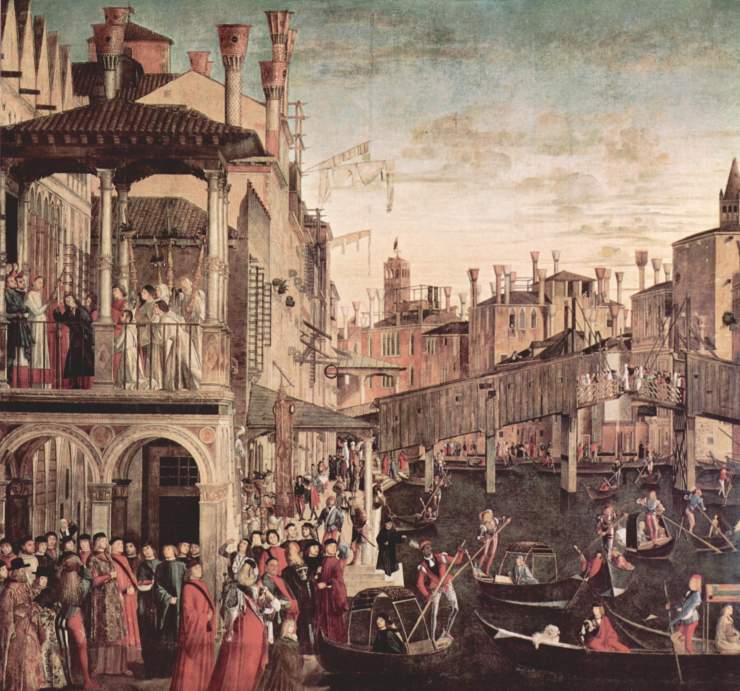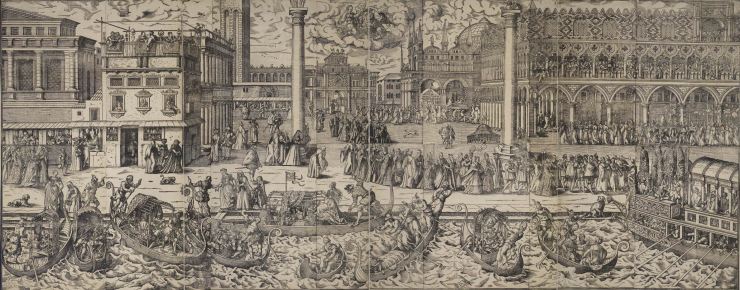By Rosa Salzberg
I was unable to participate in the Mobile and Temporary Domesticities workshop at the Geffrye Museum, but I took a keen interest in it due to my current research on spaces of arrival for migrants and travellers in Renaissance Venice. By the sixteenth century, Venice was one of the largest, and most mobile, cities of Renaissance Europe. As a major trading centre and the capital of a vast empire, it was a destination – at least a temporary one – for streams of people on the move. How to accommodate these many migrants and visitors in the crowded urban environment, whether they were intending to settle or stay only a short time, was a crucial and sensitive question that concerned the Venetian government and many of the city’s inhabitants, not to mention the new arrivals themselves.

My research focuses on the major sites of commercial hospitality – inns and lodging houses – in which many people made their first or temporary homes in the metropolis. The inns, or osterie, were large, closely-regulated and centrally-located, and accommodated primarily short-term visitors such as merchants, students and diplomats. But they could hardly cater to the streams of people disembarking in Venice in this period, and my research has uncovered a much broader network of lodging houses spread across the city. Venetian inhabitants of all kinds (many of them women, often widows, and frequently immigrants themselves) opened up their houses to newcomers and shared domestic space with them, earning a valuable income. As it exploded in the sixteenth century, this large informal lodging economy became a cause of anxiety to the government, as it was difficult to tax and regulate (not unlike a pre-modern Airbnb). However, it was crucial in providing a much wider range of arrivals (artisans, women looking for work as domestic servants, sailors, and many others) with temporary or longer-term homes. In addition to mapping and profiling this underground economy of hospitality, I am exploring how these spaces offered opportunities for interaction between urban inhabitants and visitors, leading to instances of exchange (and conflict) over intimate matters such as cooking, hygiene, and devotional practices.
Under the auspices of my current project, in November 2017 I organised a workshop entitled Arrival Cities: Urban Spaces of Mobility in Europe, Past and Present at the European University Institute in Florence. The idea behind the workshop was to bring together historians and architectural historians with scholars in other disciplines (particularly sociology and urban studies), in order to compare approaches to these spaces in the past and present, and to encourage reflection on a range of methodologies. Several of the papers presented touched particularly on the theme of “mobile and temporary domesticities”. The historian Eleonora Canepari from Aix-Marseille University examined the variety of temporary accommodation for workers and travellers moving between the centre of Rome and its rural peripheries in the seventeenth century, from inns and taverns to makeshift shacks in vineyards and lodgings in city gates. Daniel Maudlin, an architectural historian from the University of Plymouth, shared insights from his research into coaching inns in eighteenth-century Britain, showing how this emerging network of hospitality sites functioned as material and architectural spaces of great importance to elite mobility and sociability. Céline Regnard (also of Aix-Marseille University), spoke about the significant lodging sector in late nineteenth-century Marseille, a major port city that accommodated numerous transit migrants en route to North America.

A number of papers also considered some of the spaces occupied by migrants in contemporary European cities, including domestic spaces. Giada Giustetto, a member of the European Research Council-funded ‘Bodies over Borders’ (BABE) project based at the European University Institute, discussed her research collecting oral and visual records from recent migrants, recording their perceptions of the homes they had left behind compared to their new homes in Italy, and the objects and customs that remained important to them on their journeys. Adriano Cancellieri and Giovanna Marconi, researchers associated with the UNESCO chair on the ‘Social and Spatial Inclusion of Migrants in European Cities – Urban Policies and Practices’ at the IUAV University of Architecture in Venice, presented some examples of the way in which research, policy and action come together in their work with recent migrants. Not unlike the spaces of reception around the walls of early modern cities, Adriano and Giovanna described the squalid conditions of a refugee reception centre on the Italian mainland: only a few kilometres from the splendours of Venice, and yet all but invisible to most locals and visitors. These scholars of contemporary migration have the advantage of being able to ‘access’ and document the point of view of migrants themselves, even the most marginalised. Nonetheless, the historians showed how a focus on the material and physical nature of the spaces occupied by migrants in the past can provide new insight into their experiences even when personal testimonies of mobility are very difficult to recover.
Some of the persistent themes discussed at the workshop included how mobility has always played a major role in shaping European cities; the movement of people necessitating an infrastructure of more or less permanent spaces to accommodate them. In the early modern period, cities and states had less capacity to monitor, control and direct the flows of people that passed through them. And yet, polities like Venice did make very early efforts to do so by policing their borders, attempting to distinguish ‘desirable’ from ‘undesirable’ migrants and accommodate (or deport) them accordingly. Authorities may have more resources now to identify and track people on the move, but migrants continue to find spaces to occupy even when they are officially unwanted, whether in peripheral neighbourhoods where they find temporary homes or in public spaces such as the areas around train stations which often become important social sites for recent arrivals. Across the various papers it was clear that, despite the variety of spaces considered, first or temporary homes played a critical role in the journeys of mobile people: as places to find their feet, make contacts, look for work, and orient themselves in the ways of the metropolis.
Rosa Salzberg is Associate Professor of Italian Renaissance History at the University of Warwick. In 2016-18, she is a Marie Skłodowska-Curie Fellow at the European University Institute in Florence. The project and workshop described above are funded by the European Union’s Horizon 2020 research and innovation programme under the Marie Skłodowska-Curie grant agreement No 702296.
